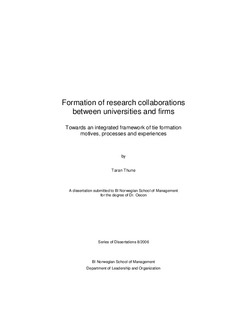Formation of research collaborations between universities and firms: Towards an integrated framework of tie formation motives, processes and experiences
Doctoral thesis
Permanent lenke
http://hdl.handle.net/11250/94282Utgivelsesdato
2006Metadata
Vis full innførselSamlinger
Sammendrag
The purpose of the study is to address the following research questions: What are the preconditions for forming ties between academic research environments and firms, and do such preconditions have anything to say for how knowledge exchange processes are carried out?
The analysis indicates that tie formation behavior can be understood in terms of two dimensions – dependence and network embeddedness. The two dimensions are related, but which focus is most central seems to be different in particular formation processes. Due to this, a typology categorizing four different tie formation processes was identified: created, needs driven, opportunity driven and interdependence driven formation processes. The analysis also indicates that there is a relationship between how collaborative research projects are formed and how the interaction process is experienced. Collaborative R&D projects formed based on personal contacts are experienced as more positive and with stronger expectancy of further continuation. How important the collaborative R&D project is for the firm, as reflected in its motives and commitment, also seem to be related to interaction experiences. Collaborative research projects formed based on both previous contacts and experienced needs are experienced as more positive overall. Projects that have been established only with previous contacts or strategic needs are seen as less positive and with less expectation of continuance.
These findings have implications for research and innovation policies that have not taken account of the different resources needed to form ties and carry out knowledge interaction between firms and universities, and they have a particular relevance for policies attempting to strengthen the ties between firms that previously have not collaborated with research environments and universities. The findings indicate that successful relationships grow out of prior established social and, even more important, knowledge ties. An implication is that even though boundary organizations and brokers attempt to mitigate the cognitive and social distance between such firms and universities, successful interaction might be very difficult.
Serie
Series of Dissertations8/2006
